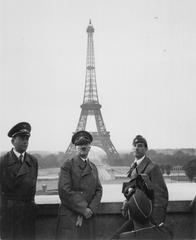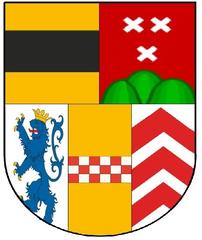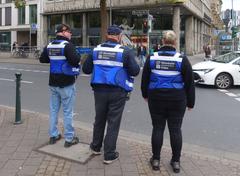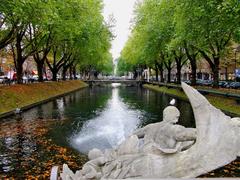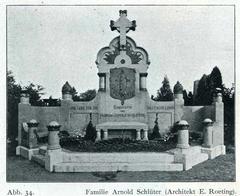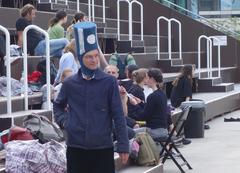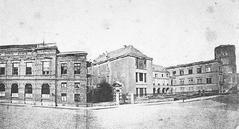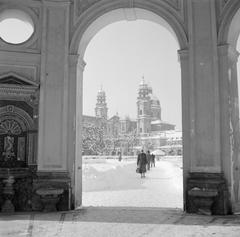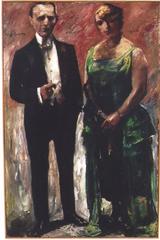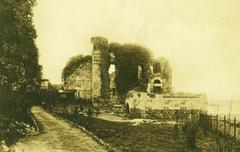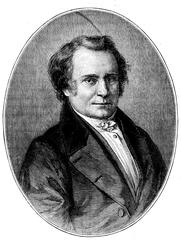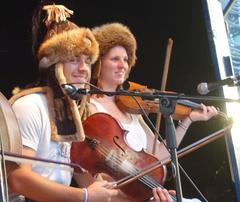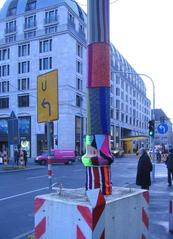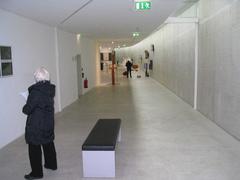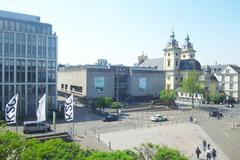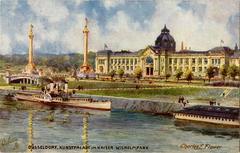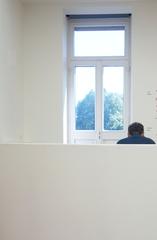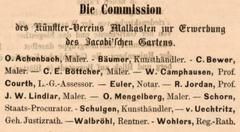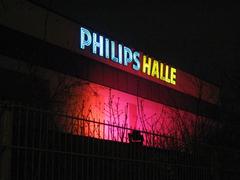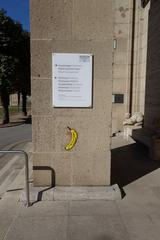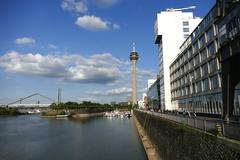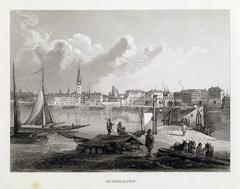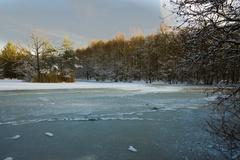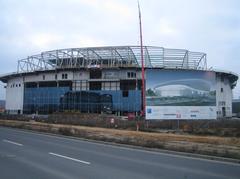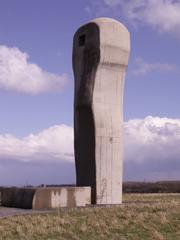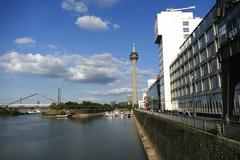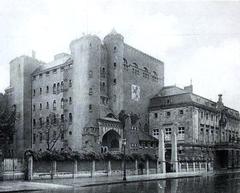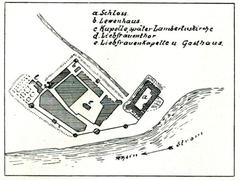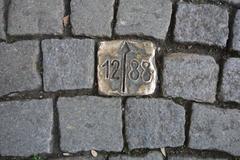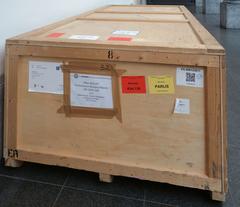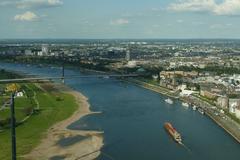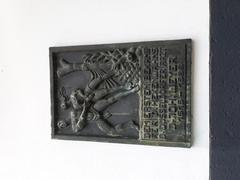
Oberkasseler Brücke Visiting Hours, Tickets, and Düsseldorf Historical Sites Guide
Date: 04/07/2025
Introduction
The Oberkasseler Brücke is one of Düsseldorf’s most prominent landmarks, seamlessly merging historical legacy, engineering innovation, and vibrant urban culture. Spanning the Rhine River, it connects the bustling city center to the picturesque Oberkassel district, serving as both a vital transport artery and a cherished social hub. With its striking cable-stayed design, panoramic city views, and a history that reflects Düsseldorf’s resilience and growth, the bridge is a must-visit for architecture enthusiasts, history buffs, photographers, and travelers alike. This guide provides detailed information on visiting hours, accessibility, travel tips, nearby attractions, and ongoing upgrades—ensuring you make the most of your visit to this iconic site (Industriekultur Düsseldorf, baukunst-nrw.de, RP Online).
Historical Overview
Origins and Early Development
Inaugurated in 1898 as Düsseldorf’s first permanent bridge across the Rhine, the Oberkasseler Brücke replaced unreliable floating crossings. The initiative, led by the Rheinische Bahn-Gesellschaft, anticipated the economic and residential development of Oberkassel, making the bridge integral to the region’s urban expansion. The original structure featured two grand arches and ornate portals, serving both rail and road traffic.
Transformations, Wartime Destruction, and Reconstruction
Over time, the bridge was widened (1925–1926) to accommodate growing traffic, with the original portals removed. From 1934 to 1945, it was renamed “Skagerrak-Brücke” during the Nazi era. In April 1945, retreating German forces destroyed the bridge to halt Allied advancement. Temporary solutions followed, including the Freeman-Bridge and a durable “Dauerbehelfsbrücke,” until the current bridge’s construction began in the early 1970s (Industriekultur Düsseldorf).
The Modern Cable-Stayed Bridge
Completed in 1976, the present Oberkasseler Brücke exemplifies post-war German engineering. Notable for its 104-meter-high pylon and 614-meter length, the bridge was constructed slightly upstream from its predecessor and hydraulically shifted into position in a remarkable feat of civil engineering (baukunst-nrw.de).
Architectural and Cultural Significance
Engineering Highlights
The Oberkasseler Brücke’s cable-stayed design, with its slender deck and inclined cables, provides both aesthetic elegance and structural efficiency. The wide roadways, dedicated tram tracks, and generous pedestrian and cycle paths reflect modern urban planning. Its minimal visual obstruction allows for uninterrupted views of the Rhine and the cityscape (baukunst-nrw.de, vvv-linksrheinisch.de).
Urban Identity and Social Hub
The bridge stands as a symbol of Düsseldorf’s post-war resurgence and progressive spirit. It is a lively meeting place, especially on weekends, for walkers, cyclists, and street performers. Its open design and river views make it a favorite among photographers and artists (evendo.com, komoot.com).
Visiting Information
Visiting Hours and Ticket Policy
- Open 24/7: The Oberkasseler Brücke is publicly accessible at all hours, every day of the year.
- No Entrance Fee: No ticket or fee is required to cross the bridge by foot, bicycle, tram, or car.
Accessibility
- Barrier-Free: The bridge features ramps at both ends, smooth wide pathways, and is suitable for wheelchairs and strollers.
- Public Transport: Multiple tram (707, 708, U74, U76, U77) and Stadtbahn lines (U70, U74, U75, U76, U77) stop near or cross the bridge (evendo.com, de.wikipedia.org).
Getting There
- By Public Transport: Use the extensive tram and Stadtbahn network for hassle-free access.
- By Car: Parking is limited, especially during events and construction. Park & Ride options are advisable (duesseldorf-parken.de).
- By Bicycle: Dedicated cycle lanes cross the bridge. Bike-sharing services are available (timeout.com).
- On Foot: The bridge links directly to the city center, promenade, and Oberkassel’s residential area.
Key Features and Attractions
Panoramic Views & Best Photography Spots
Enjoy sweeping vistas of the Altstadt’s skyline, Rheinturm, and MedienHafen. Sunset and evening walks offer particularly dramatic photo opportunities, especially during citywide events with fireworks.
Nearby Attractions
- Oberkassel District: Renowned for its Art Nouveau architecture, stylish cafés, and leafy boulevards.
- Rhine Promenade: A scenic riverside walk or cycle path with access to river cruises.
- City Beach & Parks: Adjacent green spaces and the vibrant Stadtstrand offer leisure and cultural programming (stadtklang.org, visitduesseldorf.de).
Events and Seasonal Highlights
- Japan-Tag (May): The bridge is a prime vantage point for fireworks; car access is restricted, but pedestrian and cycle paths remain open (D.LIVE).
- Rheinkirmes (July): Major funfair with similar restrictions and spectacular river views.
- City Beach Events: Daily cultural and recreational programs in summer (visitduesseldorf.de).
Current Construction and Safety Upgrades (2025)
Ongoing renovations include raising the bridge’s railings for improved pedestrian and cyclist safety, with minimal disruption as only one sidewalk closes at a time. Construction pauses during major events, and all vehicle and bicycle lanes remain operational (RP Online).
Practical Tips
- Weather: The bridge is exposed—dress accordingly and check forecasts (wanderlog.com).
- Peak Times: Visit early morning or late afternoon for fewer crowds and optimal light.
- Amenities: Public toilets and food trucks are available near the city beach; a small fee applies for restroom use (stadtklang.org).
- Transport: Use public transport or Park & Ride during events and construction. Validate tickets before boarding.
Frequently Asked Questions (FAQ)
Q: Are there entrance fees or tickets required to visit the Oberkasseler Brücke?
A: No, the bridge is publicly accessible at all times and free for everyone.
Q: Is the bridge wheelchair accessible?
A: Yes, there are barrier-free ramps and wide walkways suitable for wheelchairs and strollers.
Q: Can I cycle across the Oberkasseler Brücke?
A: Yes, with dedicated cycling lanes provided.
Q: What are the best times to visit for photos?
A: Early mornings, late afternoons, and during city events like Japan-Tag and Rheinkirmes.
Q: How can I get to the bridge by public transport?
A: Multiple tram and Stadtbahn lines serve stops at both ends of the bridge.
Q: Will construction affect my visit?
A: Minimal disruption is expected; one sidewalk may be closed, but other lanes remain open.
Internal Links
For more on Düsseldorf’s attractions, see:
Visuals and Interactive Media
- Include high-resolution images of the bridge at different times of day, detailed shots of the pylon, panoramic Rhine views, and historic photographs.
- Alt tags: “Oberkasseler Brücke Düsseldorf cable-stayed bridge at sunset”, “View from Oberkasseler Brücke over the Rhine”, “Historic Oberkasseler Brücke 1898”.
- Embed interactive maps showing public transport stops, cycling/walking routes, and nearby attractions.
Conclusion
The Oberkasseler Brücke is a living symbol of Düsseldorf’s resilience, innovation, and sociocultural vibrancy. Its accessible design, engineering significance, and prime location make it an essential stop for anyone seeking to experience the city’s spirit—whether for a daily commute, a scenic stroll, or the celebration of major events. Plan your visit, enjoy the views, and immerse yourself in Düsseldorf’s unique blend of history and modernity.
For updates, travel tips, and curated tours, download the Audiala app and follow us on social media. Make your Düsseldorf experience truly unforgettable!
References
- Industriekultur Düsseldorf
- baukunst-nrw.de
- RP Online
- vvv-linksrheinisch.de
- komoot.com
- evendo.com
- stadtklang.org
- visitduesseldorf.de
- de.wikipedia.org
- timeout.com
- wanderlog.com
- Japan-Tag Düsseldorf
- duesseldorf-parken.de
- maps.duesseldorf.de



